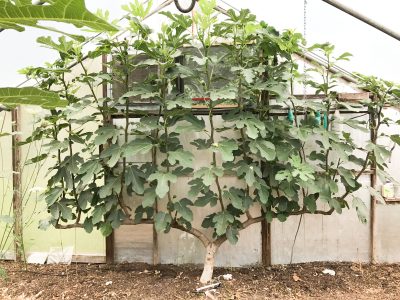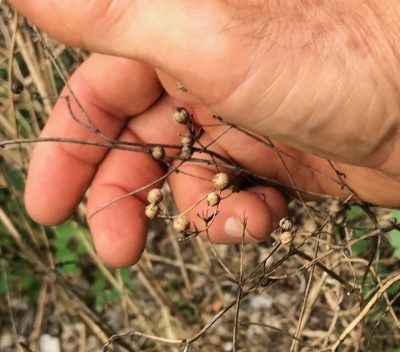Figs and Peppers and . . .
Fig Frustrations and Joys
Over the years I’ve shared the joys and frustrations of growing figs in my minimally heated greenhouse. The joys, of course, have been in sinking my teeth into fruits of the various varieties. Also, more recently, the neat appearance of the plants which are trained as espaliers.  Left to its own devices, a fig can grow into a tangled mess. In part, that’s because fig trees can’t decide if they want to be small trees, with single or a few trunks, or large shrubs, with sprouts and side branches popping out all over the place.
A major frustration in my greenhouse fig journey has been insects, both scale insects and mealybugs. These pests never attack my potted figs which summer outdoors and winter indoors in my barely heated basement. In the greenhouse the problem each year became more and more severe, eventually rendering many of the ripe fruits inedible.
Left to its own devices, a fig can grow into a tangled mess. In part, that’s because fig trees can’t decide if they want to be small trees, with single or a few trunks, or large shrubs, with sprouts and side branches popping out all over the place.
A major frustration in my greenhouse fig journey has been insects, both scale insects and mealybugs. These pests never attack my potted figs which summer outdoors and winter indoors in my barely heated basement. In the greenhouse the problem each year became more and more severe, eventually rendering many of the ripe fruits inedible. All that despite my attempts at control by going over plants with a toothbrush dipped in alcohol, oil sprays, and sticky barriers to keep ants, which “farm” these pests, from climbing up the trunks.
All that despite my attempts at control by going over plants with a toothbrush dipped in alcohol, oil sprays, and sticky barriers to keep ants, which “farm” these pests, from climbing up the trunks.
 Left to its own devices, a fig can grow into a tangled mess. In part, that’s because fig trees can’t decide if they want to be small trees, with single or a few trunks, or large shrubs, with sprouts and side branches popping out all over the place.
A major frustration in my greenhouse fig journey has been insects, both scale insects and mealybugs. These pests never attack my potted figs which summer outdoors and winter indoors in my barely heated basement. In the greenhouse the problem each year became more and more severe, eventually rendering many of the ripe fruits inedible.
Left to its own devices, a fig can grow into a tangled mess. In part, that’s because fig trees can’t decide if they want to be small trees, with single or a few trunks, or large shrubs, with sprouts and side branches popping out all over the place.
A major frustration in my greenhouse fig journey has been insects, both scale insects and mealybugs. These pests never attack my potted figs which summer outdoors and winter indoors in my barely heated basement. In the greenhouse the problem each year became more and more severe, eventually rendering many of the ripe fruits inedible. All that despite my attempts at control by going over plants with a toothbrush dipped in alcohol, oil sprays, and sticky barriers to keep ants, which “farm” these pests, from climbing up the trunks.
All that despite my attempts at control by going over plants with a toothbrush dipped in alcohol, oil sprays, and sticky barriers to keep ants, which “farm” these pests, from climbing up the trunks. Scale and mealybugs are hard to control, let alone eradicate. Yet I am now secure enough in my victory to have claimed success in the battle.
Success began last year, when research pointed me to two predators of these pests, Chrysoperla rufilabris and Cryptolaemus montrouzieri, both of which I ordered online and released into the greenhouse. They were expensive, bringing the cost of my fresh figs to about one dollar each. Still worth it, though.
I got to thinking, “Perhaps I could perennialize these predators in the greenhouse so that additional annual purchases would be unnecessary.” As a first step to creating a home (or a jail, depending on your perspective) for them, I covered all greenhouse openings to the outdoors with window screening. These predators also like moisture, so I periodically spritzed the greenhouse and laid some absorbent wads of paper here and there on the branches.
I further thought, “How does the greenhouse environment differ from the great outdoors, where my figs are pest-free?” Rainfall! Although the greenhouse environment is humid, water never falls on the plants’ leaves and stems. So rather than period spritzing, almost every day since early spring I have blasted leaves, stems, and developing fruits with water. The result: I haven’t seen one mealybug or scale insect all season!
Success, Who Knows Why?
I have to restrain myself from the usual gardener’s hubris in thinking that what I did cured the problem. Perhaps the “rainfall” favored the predators, of which there’s been nary a sign, by knocking the pest insects off the plant, or by creating a moist environment inimical to the pests, or . . . Perhaps my screening the greenhouse cured the problem. Perhaps the pest problem disappeared for none of these reasons. Or from some combination of these reasons.
If I had a full-blown experimental station and was willing to sacrifice some fresh figs to science, I could possible sleuth out the answer with control plants to what happened. But I don’t, so I’ll just keep enjoying and be thankful for the fresh figs — and keep a close eye on what’s going on.
Dondé Está la Salsa?
I have a lot of faith in natural systems (aka Mother Nature), but sometimes she gets things mixed up. Case in point relates to peppers. The pepper crop this year is excellent, mostly because I staked each plant, weeded well, and grew varieties that do well here (Escamillo, Carmen, Perperoncini, and, best of all for flavor and production, Sweet Italia).
What can be done with excess peppers? Salsa, of course.
But a key ingredient for salsa is cilantro, which enjoys cool weather both for germination and growth. Self-seeded cilantro plants were sprouting and growing all over the place a few months ago. The dried stems topped by BB-sized seeds is all that remains of them.  Those seeds will drop and germinate in the cooler temperature a few weeks hence. But I need cilantro now.
With foresight, I could have collected and sown these seeds a few weeks ago. The plants would have bolted (put energy into flowers rather than leaves) rather quickly but repeated sowings would have kept me in fresh new plants.
Those seeds will drop and germinate in the cooler temperature a few weeks hence. But I need cilantro now.
With foresight, I could have collected and sown these seeds a few weeks ago. The plants would have bolted (put energy into flowers rather than leaves) rather quickly but repeated sowings would have kept me in fresh new plants.
 Those seeds will drop and germinate in the cooler temperature a few weeks hence. But I need cilantro now.
With foresight, I could have collected and sown these seeds a few weeks ago. The plants would have bolted (put energy into flowers rather than leaves) rather quickly but repeated sowings would have kept me in fresh new plants.
Those seeds will drop and germinate in the cooler temperature a few weeks hence. But I need cilantro now.
With foresight, I could have collected and sown these seeds a few weeks ago. The plants would have bolted (put energy into flowers rather than leaves) rather quickly but repeated sowings would have kept me in fresh new plants. Belatedly, I have sown those seeds. To speed germination, I soaked them, then planted them in seed flats I kept in the refrigerator for a day and then moved to a cool, shaded area. Optimum temperatures for germination and growing of cilantro is 50-85° F. As I write, the temperature is in the mid-90s.
Fig Redux, One Week Later, A Bummer
Yes, mealybugs are still not to be seen. But now I see closely related scale insects. And plenty of them.  So I started the water sprays again, which have the potential problem of creating so much humidity and moisture that ripening figs rot. On the other hand, it might set back the scale, perhaps by knocking off ants, who “farm” scale. I also ordered a new predator, one for scale, Aphytis melinus.
So I started the water sprays again, which have the potential problem of creating so much humidity and moisture that ripening figs rot. On the other hand, it might set back the scale, perhaps by knocking off ants, who “farm” scale. I also ordered a new predator, one for scale, Aphytis melinus.
 So I started the water sprays again, which have the potential problem of creating so much humidity and moisture that ripening figs rot. On the other hand, it might set back the scale, perhaps by knocking off ants, who “farm” scale. I also ordered a new predator, one for scale, Aphytis melinus.
So I started the water sprays again, which have the potential problem of creating so much humidity and moisture that ripening figs rot. On the other hand, it might set back the scale, perhaps by knocking off ants, who “farm” scale. I also ordered a new predator, one for scale, Aphytis melinus.
